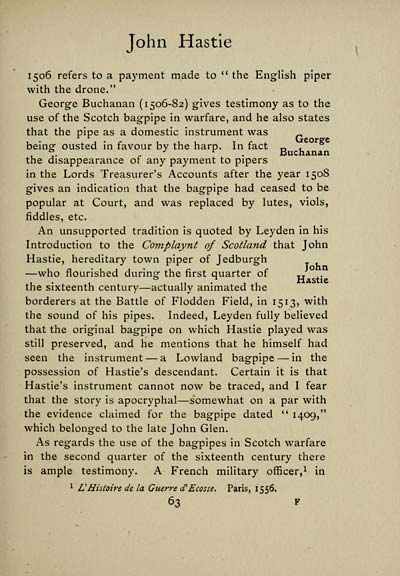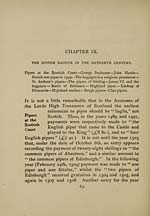Inglis Collection of printed music > Printed text > Story of the bagpipe
(89) Page 63
Download files
Complete book:
Individual page:
Thumbnail gallery: Grid view | List view

John Hastie
1506 refers to a payment made to " the English piper
with the drone."
George Buchanan (1506-82) gives testimony as to the
use of the Scotch bagpipe in warfare, and he also states
that the pipe as a domestic instrument was
bein°f ousted in favour by the harp. In fact „ ,
,. _ . Buchanan
the disappearance of any payment to pipers
in the Lords Treasurer's Accounts after the year 1508
gives an indication that the bagpipe had ceased to be
popular at Court, and was replaced by lutes, viols,
fiddles, etc.
An unsupported tradition is quoted by Leyden in his
Introduction to the Complaynt of Scotland that John
Hastie, hereditary town piper of Jedburgh
— who flourished during the first quarter of „ .
the sixteenth century — actually animated the
borderers at the Battle of Flodden Field, in 151 3, with
the sound of his pipes. Indeed, Leyden fully believed
that the original bagpipe on which Hastie played was
still preserved, and he mentions that he himself had
seen the instrument — a Lowland bagpipe — in the
possession of Hastie's descendant. Certain it is that
Hastie's instrument cannot now be traced, and I fear
that the story is apocryphal — somewhat on a par with
the evidence claimed for the bagpipe dated " 1409,"
which belonged to the late John Glen.
As regards the use of the bagpipes in Scotch warfare
in the second quarter of the sixteenth century there
is ample testimony. A French military officer, 1 in
1 LHistoire de la Guerre d'Ecosse. Paris, 1556.
63 F
1506 refers to a payment made to " the English piper
with the drone."
George Buchanan (1506-82) gives testimony as to the
use of the Scotch bagpipe in warfare, and he also states
that the pipe as a domestic instrument was
bein°f ousted in favour by the harp. In fact „ ,
,. _ . Buchanan
the disappearance of any payment to pipers
in the Lords Treasurer's Accounts after the year 1508
gives an indication that the bagpipe had ceased to be
popular at Court, and was replaced by lutes, viols,
fiddles, etc.
An unsupported tradition is quoted by Leyden in his
Introduction to the Complaynt of Scotland that John
Hastie, hereditary town piper of Jedburgh
— who flourished during the first quarter of „ .
the sixteenth century — actually animated the
borderers at the Battle of Flodden Field, in 151 3, with
the sound of his pipes. Indeed, Leyden fully believed
that the original bagpipe on which Hastie played was
still preserved, and he mentions that he himself had
seen the instrument — a Lowland bagpipe — in the
possession of Hastie's descendant. Certain it is that
Hastie's instrument cannot now be traced, and I fear
that the story is apocryphal — somewhat on a par with
the evidence claimed for the bagpipe dated " 1409,"
which belonged to the late John Glen.
As regards the use of the bagpipes in Scotch warfare
in the second quarter of the sixteenth century there
is ample testimony. A French military officer, 1 in
1 LHistoire de la Guerre d'Ecosse. Paris, 1556.
63 F
Set display mode to: Large image | Transcription
Images and transcriptions on this page, including medium image downloads, may be used under the Creative Commons Attribution 4.0 International Licence unless otherwise stated. ![]()
| Special collections of printed music > Inglis Collection of printed music > Printed text > Story of the bagpipe > (89) Page 63 |
|---|
| Permanent URL | https://digital.nls.uk/94510244 |
|---|
| Description | Scottish and English songs, military music and keyboard music of the 18th and 19th centuries. These items are from the collection of Alexander Wood Inglis of Glencorse (1854 to 1929). Also includes a few manuscripts, some treatises and other books on the subject. |
|---|
| Description | The Glen Collection and the Inglis Collection represent mainly 18th and 19th century Scottish music, including Scottish songs. The collections of Berlioz and Verdi collected by bibliographer Cecil Hopkinson contain contemporary and later editions of the works of the two composers Berlioz and Verdi. |
|---|

